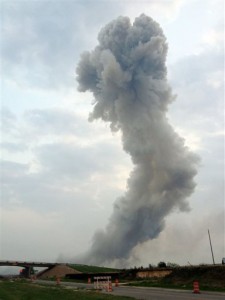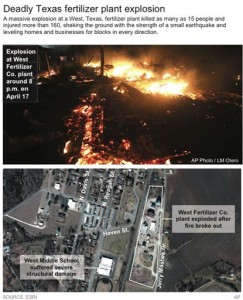Police: 5 to 15 People Killed in Texas Explosion
JOHN L. MONE, Associated Press
MICHAEL BRICK, Associated Press
WEST, Texas (AP) — A massive explosion at a Texas fertilizer plant that killed as many as 15 people and injured more than 160 left the blast site too hot for emergency teams to get close on Thursday, while rescuers searched the shattered farming community for survivors.
The Wednesday evening blast shook the ground with the strength of a small earthquake, leveling homes and businesses for blocks in every direction. Witnesses captured the searing blast and mushroom cloud on their cellphones.
The explosion in downtown West, about 80 miles (130 kilometers) south of Dallas, could be heard dozens of miles away. It sent flames shooting into the night sky and rained burning embers, shrapnel and debris on frightened residents.
“They are still getting injured folks out, and they are evacuating people from their homes,” Waco police Sgt. William Patrick Swanton said Thursday morning. “They have not gotten to the point of no return where they don’t think that there’s anybody still alive.” He did not know how many people had been rescued.
There was no indication the blast, which sent up a mushroom-shaped plume of smoke and left behind a yawning crater, was anything other than an industrial accident, Swanton said.
Morning revealed a landscape wrapped in acrid smoke and strewn with the shattered remains of buildings, furniture and personal belongings. The force of the explosion sheared away the front of an apartment complex, leaving behind twisted beams, shattered windows and great heaps of broken wood. Cars were battered as if a tornado had spun through town.

In this Wednesday, April 17, 2013, photo provided by Joe Berti, a plume of smoke rises from a fertilizer plant fire near Waco, Texas. A massive explosion at the West Fertilizer Co. killed as many as 15 people and injured more than 160, officials said Thursday morning. (AP Photo/Joe Berti)
Authorities themselves had trouble entering the heart of the blast zone.
“It’s still too hot to get in there,” said Franceska Perot, a spokeswoman for the Bureau of Alcohol, Tobacco and Firearms, said Thursday morning.
Among those believed to be dead were three to five volunteer firefighters. The many injuries included broken bones, cut and bruises, respiratory problems and minor burns. Five people were reported in intensive care.
In the hours after the blast, residents wandered the dark, windy streets searching for shelter. Among them was Julie Zahirniako, who said she and her son, Anthony, had been at a school playground near the plant when the explosion hit.
It threw her son four feet (over a meter) in the air, breaking his ribs. She said she saw people running from a nursing home, and the roof of the school lifted into the sky.
“The fire was so high,” she said. “It was just as loud as it could be. The ground and everything was shaking.”
Authorities said the plant made materials similar to those used in the 1995 Oklahoma City bombing.
The fertilizer used in that attack, ammonium nitrate, makes big explosions, be they accidental or intentional, said Neil Donahue, professor of chemistry at Carnegie Mellon University. It also was used in the first bombing attempt at the World Trade Center in 1993.
Ammonium nitrate is stable, but if its components are heated up sufficiently, they break apart in a runaway explosive chemical reaction, Donahue said.
“The hotter it is, the faster the reaction will happen,” Donahue said. “That really happens almost instantaneously, and that’s what gives the tremendous force of the explosion.”
West Mayor Tommy Muska told reporters that his city of about 2,800 people needs “your prayers.”
“We’ve got a lot of people who are hurt, and there’s a lot of people, I’m sure, who aren’t going to be here tomorrow,” Muska said.
About a half-hour before the blast, the town’s volunteer firefighters had responded to a call at the plant, Swanton said. They immediately realized the potential for disaster because of the plant’s chemical stockpile and began evacuating the surrounding area.
The blast happened 20 minutes later.
The main fire was under control late Wednesday, but residents were urged to remain indoors because of the threat of new explosions or leaks of ammonia.
First-responders evacuated 133 dazed patients from the nursing home, some in wheelchairs.
The U.S. Chemical Safety Board was deploying a large investigation team to the site. An ATF national response team that investigates all large fires and explosions was also expected, bringing fire investigators, certified explosives specialists, chemists, canines and forensic specialists.
There were no immediate details on the number of people who work at the plant, which was cited by the Texas Commission on Environmental Quality in 2006 for failing to obtain or to qualify for a permit. The agency acted after receiving a complaint in June of that year of a strong ammonia smell.
The Chemical Safety Board has not investigated a fertilizer plant explosion before, but Managing Director Daniel Horowitz said “fertilizers have been involved in some of the most severe accidents of the past century.”
He noted the 2001 explosion at a chemical and fertilizer plant that killed 31 people and injured more than 2,000 in Toulouse, France. The blast occurred in a hangar containing 300 tons of ammonium nitrate and came 10 days after the Sept. 11, 2001, terrorist attacks in the U.S., raising fears at the time it was linked. A 2006 report blamed the blast on negligence.
Horowitz also mentioned the 1947 Texas City disaster, when a fire in a cargo ship holding more than 2,000 tons of ammonium nitrate caught fire and exploded, killing more than 500 people.
Associated Press writers Schuyler Dixon, Nomaan Merchant and Terry Wallace in Dallas; Betsy Blaney in Lubbock and Seth Borenstein in Washington and video journalist Raquel Dillion in West contributed to this report.
Copyright 2013 The Associated Press.


